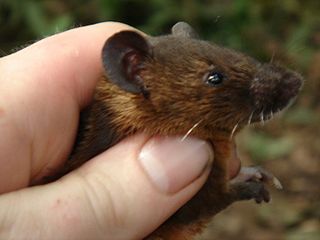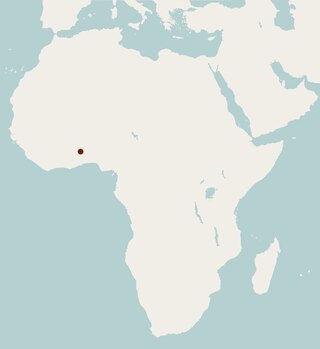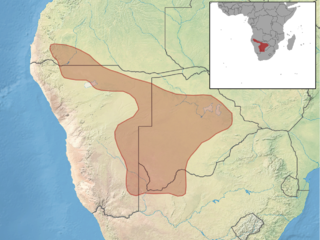
The brush-furred mice, genus Lophuromys are a group of rodents found in sub-Saharan Africa. They are members of the subfamily Deomyinae, a group only identifiable through molecular analysis. Lophuromys is also known as the brush-furred rats, harsh-furred rats or coarse-haired mice.
The link rat is a species of rodent in the family Muridae. It is also known by the common name Congo forest mouse. It is native to central Africa.

The Togo mouse, also known as Büttner's African forest mouse or the groove-toothed forest mouse, is a unique muroid rodent known from only two specimens taken from near the type locality of Bismarckburg, near Yege, Togo, in 1890. Its genus is monotypic.
The short-tailed brush-furred rat is a species of rodent in the family Muridae. It is found only in Ethiopia. Its natural habitats are subtropical or tropical high-altitude shrubland and subtropical or tropical high-altitude grassland. It is threatened by habitat loss.
The Ethiopian forest brush-furred rat or golden-footed brush-furred rat, is a species of rodent in the family Muridae. It is endemic to Ethiopia where its natural habitat is subtropical or tropical moist montane forests. It is threatened by habitat loss.
The gray brush-furred rat is a species of rodent in the family Muridae. It is found only in Democratic Republic of the Congo. Its natural habitats are subtropical or tropical swamps, subtropical or tropical moist montane forests, and subtropical or tropical high-altitude grassland. It is threatened by habitat loss.
Dieterlen's brush-furred mouse, Mt Oku brush-furred mouse, or Mount Oku brush-furred rat is a species of rodent in the family Muridae. It is endemic to Mount Oku, Cameroon. Its natural habitat is montane forest at elevations above 2,000 m (6,600 ft).
The yellow-spotted brush-furred rat is a species of rodent in the family Muridae found in Angola, the Democratic Republic of the Congo, Ethiopia, Kenya, Malawi, Mozambique, South Sudan, Tanzania, and Zambia. Its natural habitats are subtropical or tropical moist lowland forest, subtropical or tropical moist montane forest, and subtropical or tropical high-altitude grassland. The population in Ethiopia is isolated and can be found at high altitudes up to 4,500 m above sea level.
Hutterer's brush-furred mouse or Hutterer's brush-furred rat is a species of rodent in the family Muridae. It is found only in Democratic Republic of the Congo, where its natural habitat is subtropical or tropical moist lowland forests.
The yellow-bellied brush-furred rat is a species of rodent in the family Muridae. It has been recorded from the Democratic Republic of the Congo, Rwanda, and Uganda. It lives in rainforest and swamps. Although the species is considered to be rare, there do not seem to be any extant major threats to the population, and it is classified as Least Concern by the IUCN.
The medium-tailed brush-furred rat is a species of rodent in the family Muridae. It has been recorded from the Democratic Republic of the Congo, Rwanda, and Uganda. It lives in rainforest and swamps. It is a rare species which is threatened by habitat loss.
The black-clawed brush-furred rat is a species of rodent in the family Muridae. It is found only in Ethiopia. Its natural habitat is subtropical or tropical high-altitude grassland. It is threatened by habitat loss.
The fire-bellied brush-furred rat is a species of rodent in the family Muridae. It is found in Cameroon, Central African Republic, the Republic of the Congo, the Democratic Republic of the Congo, Equatorial Guinea, and Gabon. Its natural habitat is subtropical or tropical moist lowland forests.
Rahm's brush-furred rat is a species of rodent in the family Muridae. It is found in Democratic Republic of the Congo, Rwanda, and Uganda. Its natural habitat is subtropical or tropical moist montane forests. It is threatened by habitat loss.
The Mount Cameroon brush-furred rat or Rosevear's brush-furred mouse is a species of rodent in the family Muridae. It is found only in Cameroon. Its natural habitats are subtropical or tropical moist montane forests, subtropical or tropical moist shrubland, subtropical or tropical high-altitude shrubland, subtropical or tropical high-altitude grassland, plantations, and rural gardens.

Woosnam's broad-headed mouse or Woosnam's zelotomys is a species of rodent in the family Muridae. It is found in Angola, Botswana, Namibia, and South Africa. Its natural habitat is dry savanna.

Synodontis woosnami, known as the Upper Zambezi squeaker, or bubblebarb squeaker, is a species of upside-down catfish that is native to Angola, Botswana, Namibia, Zambia and Zimbabwe where it is found in the upper Zambezi and Okavango River basins and the Cunene River. It was first described by British-Belgian zoologist George Albert Boulenger in 1911, from a specimen collected in the Okavango River in the Lake Ngami district of Botswana. The species name woosnami is derived from R. B. Woosnam, the collector of the first specimen.
Thomas's Ethiopian brush-furred rat, also called the brown brush-furred rat or the brown brush-furred mouse, is a species of brush-furred mouse from Southern Ethiopia.




